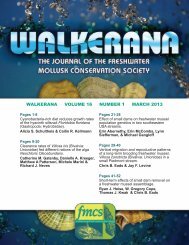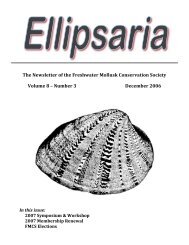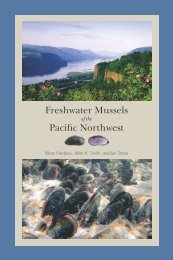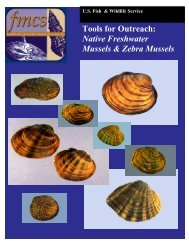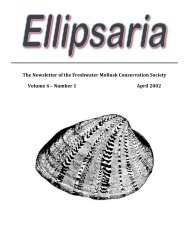Ellipsaria - Freshwater Mollusk Conservation
Ellipsaria - Freshwater Mollusk Conservation
Ellipsaria - Freshwater Mollusk Conservation
Create successful ePaper yourself
Turn your PDF publications into a flip-book with our unique Google optimized e-Paper software.
Preliminary Checklist of <strong>Freshwater</strong> Snails by River Basins of the Chesapeake Bay,<br />
Maryland.<br />
Matt Ashton and Pat Ciccotto<br />
Maryland Department of Natural Resources<br />
Monitoring and Non-tidal Assessment Division<br />
580 Taylor Avenue, C-2<br />
Annapolis, MD 21401<br />
Little is known regarding the distribution of Maryland’s freshwater gastropods and this poor understanding is an impediment to<br />
conservation. Gerberich (1985) provided a list of Maryland’s freshwater gastropods that included 38 native and two non-native<br />
species. Recent treatments have centered on the Potomac River basin (Fuller 1978, Pearce & Evans 2008). Two statewide<br />
monitoring programs of the Maryland Department of Natural Resources have produced an extensive database of benthic<br />
macroinvertebrate genera that allows us to present this checklist of freshwater gastropod distribution in Maryland’s streams: the<br />
Maryland Biological Stream Survey (MBSS) and CORE/TREND. The MBSS is a probabilistic survey that has assessed the<br />
ecological health and biodiversity of Maryland’s wadeable, non-tidal streams since 1995. The CORE/TREND program was<br />
established in response to the 1972 Federal Clean Water Act to document changes in water quality of Maryland’s larger rivers and<br />
streams through analyses of benthic macroinvertebrate community data. Based on data from these monitoring programs, we<br />
compiled a list of freshwater gastropod genera in Maryland by major river basin to aid in the future assessment of their statewide<br />
diversity.<br />
Snail genera were identified from approximately 3,000 MBSS sites sampled from 1995-2009 and 111 CORE/TREND benthic<br />
macroinvertebrate stations sampled on a regular basis from 1976-2008 in every major river basin across the state. MBSS benthic<br />
macroinvertebrate samples were collected by disturbing 20 ft 2 of the most productive macroinvertebrate habitat into a D-net (540μ<br />
mesh), in order of preference: riffles; root wads, root mats, and woody debris; leaf packs; macrophytes; and undercut banks.<br />
CORE/TREND sites were sampled with 0.09 m 2 Surber samplers in riffle habitats and Fullner modified Hester-Dendy samplers<br />
(~ 0.135 m 2 of substrate) in habitat that lacked riffles. Organisms in both studies were preserved in 95% ethanol and processed in<br />
the MDNR laboratory by NABS certified taxonomists. Although these methods do not specifically target gastropods, the large<br />
spatial and temporal distribution of both monitoring programs should allow for the compilation of a robust checklist.<br />
<strong>Freshwater</strong> gastropod genera by major river basin are presented in Table 1. Snails were present at 670 MBSS sites (1995-2009)<br />
and 87 CORE/TREND (1976-2008) sites. We excluded a single record of Pleurocera sp. in the Upper Potomac River basin from<br />
a CORE/TREND station pending verification and a single record of Hydrobia sp. from the Nanticoke River basin since it<br />
represents a brackish species. Of particular note is collection of the genus Radix from a single basin in Maryland. This genus<br />
consists of a single species, R. auricularia, and is not native to North America (Turgeon et al. 1998).<br />
The evolving state of freshwater mollusk taxonomy often makes the comparison to prior treatments (Fuller 1978, Gerberich 1985,<br />
Pearce & Evans 2008) and presentation of checklists difficult. We hope to use these past efforts along with recent taxonomic<br />
treatments and faunal databases (e.g. NatureServe and museums) to mine our benthic macroinvertebrate samples and resolve<br />
generic level identifications to species in order to assess the distribution and diversity of Maryland’s freshwater gastropods.<br />
Literature Cited<br />
Gerberich, A.G. 1985. The endangered and threatened freshwater mollusks of Maryland. Pp 245-266 in A. Norden, D.C.<br />
Forester, & G.H. Fenwick, eds., Threatened and endangered plants and animals of Maryland. Maryland Natural Heritage<br />
Program Special Publication 84-I.<br />
Fuller, S.H. 1978. Changes in the molluscan community of the Middle Potomac River during the past two decades. Pp 124-131<br />
in K.C. Flynn & W.T. Mason, eds., Biological resources of the Potomac basin streams. Interstate Commission of the Potomac<br />
River Basin, Rockville, MD. 194 pp.<br />
Pearce, T.A. & Evans, R. 2008. <strong>Freshwater</strong> mollusca of Plummers Island, Maryland. Bulletin of the Biological Society of<br />
Washington 15: 20-30.<br />
Turgeon, D.D. et al. 1998. Common and scientific names of aquatic invertebrates from the United Sates and Canada: <strong>Mollusk</strong>s,<br />
2 nd edition. American Fisheries Society, Special Publication 26, Bethesda, MD, 526 pp.<br />
14



